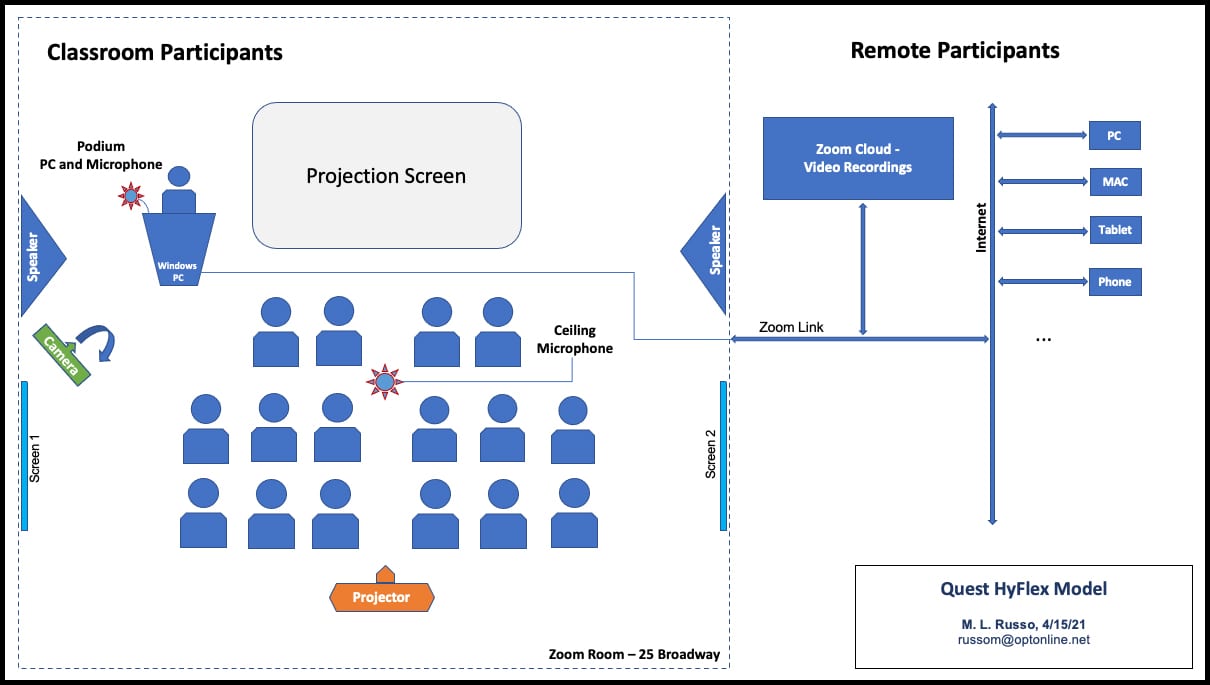HYBRID CLASSROOM
When the pandemic began in the winter of 2020, Quest instantly adjusted by changing its teaching and learning model from the standard face-to-face classroom approach to a synchronous online model of webinars and meetings using the online system called Zoom, a video and web conferencing system with webinar capability. With Zoom technology Quest held classes and meetings online, engaging its members in almost all areas of study, and continuing to carry on its business. As we look forward to returning, at least partially, to our 25 Broadway venue in the fall, we are planning to increase instructional flexibility by adding simultaneous in-person and online classes to our capabilities. Three classrooms at 25 Broadway, including the auditorium, will be outfitted with computers, projectors, speakers, microphones and cameras so that in-person classes can be simultaneously broadcast as meetings or webinars on Zoom. In-person classroom attendees, remote users, and the in-class instructor will all be able to see and communicate with each other during hybrid (in-class and online) sessions which will attempt to engage all students equally. This is accomplished by using an approach to instructional technology called “the Hyflex teaching and learning model.” What is Hyflex? Hyflex is a made-up word which combines the terms “hybrid” and “flexible.” Hybrid learning has been around for many years. It is an approach to teaching that integrates standard face-to-face classroom learning with online delivery of classroom and discussion services. Traditional hybrid classes have some in-person and some on-line classes. All students in a hybrid class attend the same in person and online sessions. In a HyFlex course, students are given a choice in how they participate, attending, alternatively, in person or online. Students engage with the instructor and the materials in the mode that works best for them on a particular day. Questers can choose how they participate in classes. They can
In addition, since all webinars are recorded and posted to the Quest video website, Questers will have yet another way of observing classes: by viewing recordings. The figure below shows a classroom implementation that illustrates the basic functionality of a HyFlex Zoom-Room implementation. Since our rooms have not yet been completed, we don’t know at this point exactly what equipment will be used, but functionality will be as depicted in the figure. |

HyFlex Classroom Setup Consider the configuration given in Figure 1, which depicts a general configuration for a one-camera, two-microphone setup. This is essentially what is being planned for our auditorium space at 25 Broadway. (The two smaller classrooms will be similar.) The camera in the figure rotates. It is aimed in the direction of the instructor while he/she is talking. The camera’s main purpose is to put the instructor’s image and immediate surroundings into the Zoom video stream for remote users. The instructor’s presentation materials are also transmitted to remote users via Zoom. So, while the instructor is talking, remote users see on their screens the PowerPoint slides and the instructor’s image from the camera, just as in a regular Zoom session. In-class users see the PowerPoint on the large screen in the front of the room and the instructor’s voice is heard over the room’s loudspeakers, just as in a normal in-class presentation. When in-class participants speak, they will be seen by the camera and heard through the ceiling microphone, so that remote users will see and hear all questions and comments offered by live class members. When remote users speak, their images will appear on the side screens (which are large flat-screen HDTV monitors) and their voices will be heard over the classroom speakers. If you have questions or comments about this page, please contact Michael Russo. |
